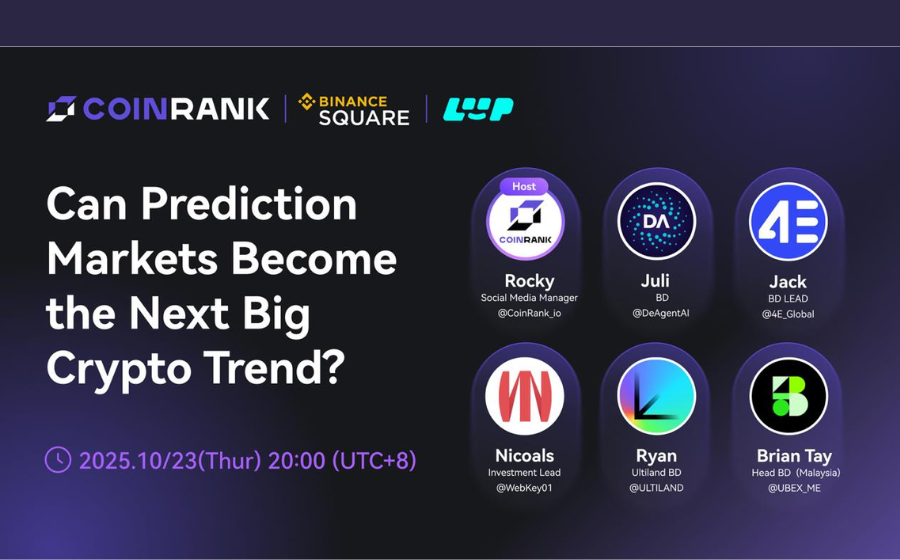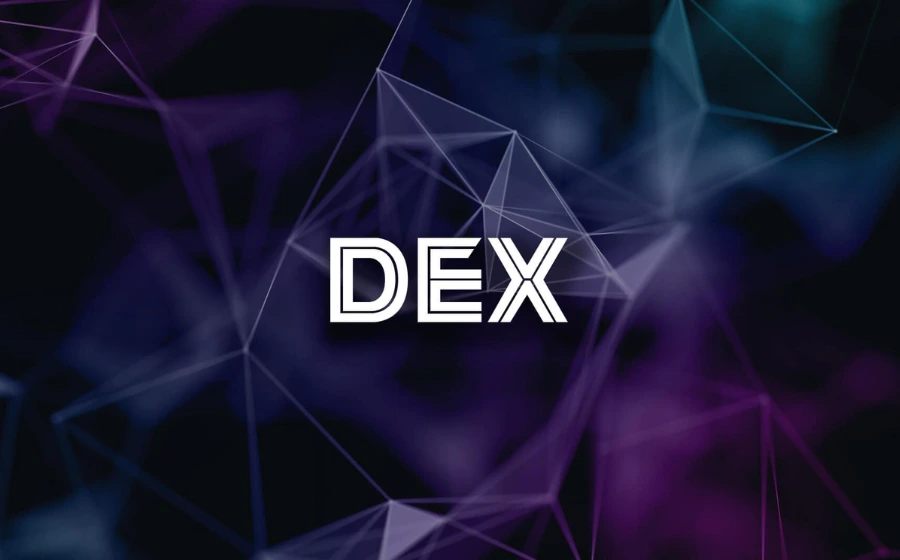
KEYTAKEAWAYS
-
Experts debate if prediction markets like PolyMarket are the next crypto revolution or just another hype wave in the AI-driven Web3 era.
-
Five blockchain leaders reveal 2025 goals, AI integrations, and risks shaping the future of decentralized prediction markets.
-
From hype to utility — how AI, liquidity, and transparency will decide the fate of crypto’s next big trend: prediction markets.

CONTENT

This AMA was hosted by Coin Rank, and the host was Rocky from Coin Rank. The event explored a key topic in crypto: with platforms like PolyMarket on the rise, will prediction markets become the next major trend in crypto, or are they just another wave of speculation?
GUEST PROJECT SHOWCASE
At the start, five guests introduced their projects, unique strengths, and goals for 2025.
Juli (The Agent AI) said the project is the largest AI agent infrastructure in the Sui, BTC, and BSC ecosystems. They can deploy various AI models to make decisions and take actions. Their flagship product, Alpha X, can predict the prices of BTC, ETH, and SUI with about 70% accuracy, far above traditional traders. In the future, they will offer an open-source framework to help developers deploy their own AI agents.
Jack (4E Global) said he is the BD Manager for 4E in APAC. 4E is a financial asset trading platform that offers spot trading, stocks, commodities, and indices. The platform focuses on safe and innovative one-stop trading services. Recently, they launched 4E Card, a new crypto payment solution that lets users spend directly from their crypto accounts.
Nicolas (WebKey) focuses on building real-world infrastructure for the Web3 economy. The project is known for its consumer smart terminal with nearly 1 million token holders. WebKey uses hardware in the real world to bridge the physical and digital worlds, giving users direct Web3 access, data ownership, and tokenized participation. Nicolas said their 2025 goals include expanding to 2 million devices and enabling direct prediction and RWA modules.
Ryan (Ultiland) said Ultiland is an innovative blockchain platform that connects real-world assets and digital audits. The platform allows real estate and certificates to be insured, valued, traded, and used as collateral, bridging real-world and crypto value. They are about to launch the first RWA tokens backed by tangible assets.
Brian Tay (UBX), Head of Business Development at UBX, said the exchange has operated for over 5 years, serving more than 150 countries. UBX aims to deliver an excellent trading experience with deep liquidity, lightning-fast execution, bank-grade security, and minimal slippage. Brian Tay stressed UBX’s focus on community, education, and transparency. They recently launched a traders’ chatroom to build an ecosystem by traders, for traders.
KEY DIFFERENCES BETWEEN PREDICTION MARKETS AND TRADITIONAL FINANCE
The guests agreed that the biggest differences are decentralization, transparency, and the goal of acting as an information aggregator.
Mechanism and Trust Differences
Juli said traditional betting or options rely on centralized systems where users must trust an institution to manage liquidity and the process. In contrast, crypto prediction markets are trustless and open. All liquidity and even outcomes happen on-chain and are transparently verified by smart contracts or oracles, not controlled by one company. Jack stressed that blockchain-based markets provide tamper-proof settlement, and rules cannot be changed retroactively.
Information Aggregation and Signal Value
Jack explained that traditional betting is usually zero-sum, while prediction markets are more like a decentralized information aggregator. They use “the wisdom of the crowd” to predict real-world events. Prices in prediction markets directly represent the market’s collective probability for an event. Nicholas stressed that in prediction markets, positions themselves become signals. The market motivates informed people to reveal information early, in search of truth. Ryan also said prediction markets focus on real-world outcomes rather than price ranges, making them a mirror of social consensus with stronger emotion and signal value.
AI and Composability
Juli added that on-chain markets are composable and can connect directly to DeFi and even AI systems. For example, autonomous agents can read real-time prediction data, analyze trends, and make decisions.
DATA INTERPRETATION AND RISK INSIGHTS
The host cited PolyMarket data as examples: a 15% chance that BTC falls below $100,000, and a 20% chance that ETH reaches $4,800. The guests discussed how to read these numbers and the limits of prediction markets.
Real-Time Reflection of Sentiment
Brian Tay said prediction markets cannot see the future, but they give a clear snapshot of current sentiment. A 15% chance means that, given current data, trader behavior, and global conditions, the collective market assigns about a 15% probability to the event. So, prediction markets should be seen as dynamic, crowd-sourced probability models, not fortune-tellers. Nicholas added that these numbers show collective expectations. For example, BTC has an 85% chance to stay above $100,000. Juli stressed that if new data appears (like major ETF approvals or macro shocks), these probabilities adjust immediately. This responsiveness makes them a real-time dashboard of collective belief.
Reliability and Manipulation Risks
Jack warned that prediction market data is not always accurate or reliable. Current market consensus often reflects the views of ordinary people, not large institutions holding most liquidity. Jack cautioned that markets with low liquidity are easy to manipulate or reflect only a small group’s views. He also said that when there is enough incentive to make a prediction come true, people may take actions to realize it. Nicolas reminded that sports betting has long had manipulation, and as more players and funds enter prediction markets, future manipulation is also possible.
HYPE CYCLE IN THE AI ERA AND SAFETY GUIDELINES
Finally, the guests discussed whether prediction markets will enter a hype cycle and offered practical advice for regular investors.
Hype Cycle and What Is Different in the AI Era
The guests generally believe prediction markets will likely go through a hype cycle similar to decentralized derivatives (DEX), and early signs are already visible. Brian Tay said the excitement is similar to early DeFi and DEX movements.
But Juli said the key difference now is that we are entering the AI era. Prediction markets are becoming the data layer for AI agents and on-chain decision systems. The key for prediction markets to go beyond hype is usefulness — becoming a reliable tool for humans and machines to understand and use probabilities.
Nicolas added that he sees prediction markets as essential, not a niche. Ryan concluded that if prediction markets enter a hype cycle, their long-term value will depend on three core factors: deep liquidity, clear regulation, and strong user retention.
PRACTICAL ADVICE FOR INVESTORS
For regular investors who want to participate safely, the guests offered the following advice:
-
Treat as an information tool: Juli suggested treating prediction markets as an information tool, not a “cannon,” and using them to test personal hypotheses. Ryan stressed using the market with a “no judgment, no emotion” mindset and not gambling.
-
Manage risk carefully: Brian Tay reminded that prediction markets are highly volatile and should be seen as high-risk tools. Juli suggested never investing more than your learning budget. Jack and Nicolas both advised that, since markets are new and manipulation risk exists, investors should do more research and start small.
-
Know the rules and transparency: Brian Tay stressed the need to understand rules and settlement standards and to know when and how a market closes. Juli added that one should choose transparent and audited platforms, ensuring public smart contract audits and on-chain verification.
-
Combine with your analysis: Brian Tay suggested using prediction markets as a complementary sentiment tool, together with your own analysis, research, and strategy. Also check liquidity and spreads, because low volume can distort implied probabilities.















